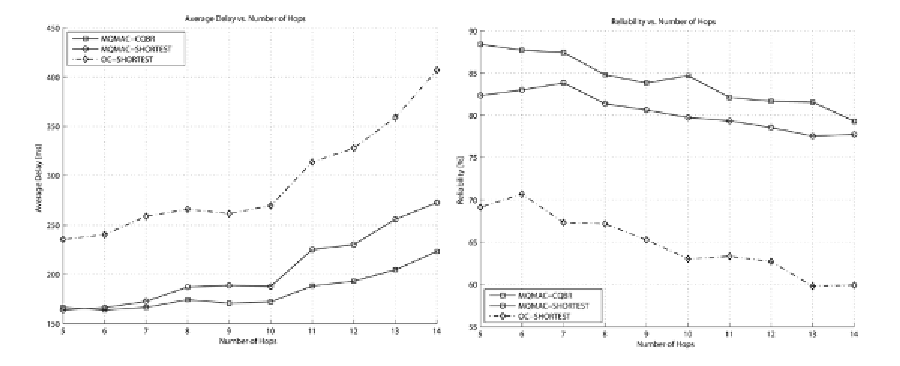Information Technology Reference
In-Depth Information
delay and reliability is compared with the fol-
lowing protocols:
Generally, a scheduler with only one queue
is not an efficient way to do EDF scheduling.
In contrast, as discussed in Sect. 4.4.1, having a
number of queues within the EDF scheduler can
decrease scheduling complexity and the queuing
delay for the packets while meeting the delay
requirements of different types of data. However,
an EDF scheduler alone only guarantees the traffic
delay, and cannot provide differentiated service
to distinct classes of traffic, e.g., the red, yellow,
and green traffic during triage.
Definition 1.
A flow
f
i
t
•
Protocol stack with one-channel CSMA/
CA MAC protocol and routing on the
path with the shortest number of hops
(OC-SHORTEST);
•
Protocol stack with our Multi-Channel MAC
and routing on the path with the shortest
number of hops (MQMAC-SHORTEST).
( )
is defined as the
traffic of the same type
t
of sensing data with the
same QoS requirement sent from source
i
to des-
tination
j
.
Obviously, the vital signs during triage have
two different QoS requirements with the first based
on patient's condition and the second from the
e2e requirement of different
flows
, as defined in
Definition 1. The first requirement is
class specific
while the second is
flow specific
. GPS schemes can
be used to provide class-specific service, which
assigns different bandwidths to different classes
of traffic. However, GPS cannot guarantee the
flow delay requirement. On the other hand, EDF
scheduling can provide guarantee e2e services
to the flows but cannot satisfy the class-specific
The evaluation results in Figure 4 show that our
solution gives better performance both in terms of
e2e delay and reliability than the other two compet-
ing protocols. The protocols are implemented in
TinyOS and the performance is measured in the
experiment setup as in Sect. 4.2.
,
Two-Level Scheduling Algorithm
The above comparisons show that the cross-
layer routing design detailed in Sect. 4.3 gives
performance improvement in terms of reliability
and delay over conventional protocols using one
channel. Yet, protocols so far have no mechanism
to guarantee the delay requirements of the traffic.
As discussed in Sect. 2.3, an EDF scheduler is an
effective way to bound the packet delay.
Figure 4. Compatison of the joint MAC and Routing Protocols

Search WWH ::

Custom Search